
For the seventeenth month, Freedom Finance Global has been studying consumer confidence, inflation and devaluation expectations of residents of four Central Asian countries including Kazakhstan, Uzbekistan, Kyrgyzstan and Tajikistan. In November 2024, mixed dynamics of consumer confidence were recorded. Growth was noted in only two countries, and in three countries there was a reversal of two-three-month trends in the index. But in the dynamics of inflationary sentiment, a deterioration is noticeable in almost all countries with sharp changes in indicators. Devaluation expectations in the region have again grown almost everywhere against the backdrop of weakening national currencies.
In November, the consumer confidence index (CCI) improved in two Central Asian countries. Kyrgyzstan showed a slight recovery in the index after two consecutive months of decline. In Tajikistan, three months of a slight decline were followed by a good recovery, having recovered most of the losses. On the other hand, Kazakhstan showed a noticeable decline after two consecutive months of growth, reaching the minimum since May 2024. In Uzbekistan, the monthly dynamics of the CCI have been reporting swings for the fourth month in a row, this time the index has noticeably decreased after the growth in October.
In Kazakhstan and Uzbekistan, analysts collect 3,600 questionnaires monthly, in Kyrgyzstan – 1,600, in Tajikistan – 1,200, proportionate to the population size in the countries under study. The research is based on the methodology used to obtain consumer confidence indices in many countries around the world and adapted to local tasks by United Research Technologies Group. The data collection method is a telephone survey. The survey questionnaire is adapted: the research is conducted in the native language of the respondents.
Kazakhstan
The consumer confidence index in Kazakhstan, in November, showed a noticeable decline after two consecutive months of growth, amounting to 101.3 points, which was the lowest figure since May this year. Deterioration in respondents’ moods occurred in four out of five sub-indices. The largest decline occurred in assessments of changes in the economic situation over the past 12 months. Compared to last November, the CCI fell by much more impressive 6.9 points, also largely due to a significant decrease in assessments of changes in the economic situation.
Sharp decline in economic optimism over the past 12 months
The sub-index of assessments of changes in the economy over the past 12 months fell sharply by 5.8 points, compared to October and amounted to 76.8 points. This result was the lowest since May. The share of Kazakhstanis who believe that favorable changes have occurred in the economy decreased from 18.7 to 16.1%. In addition, the increase in the share of negative responses is more noticeable: from 39.6 to 44.4%.
In terms of age groups, respondents aged 45–59 showed the greatest decrease in optimism. The share of positive answers among them fell from 16.7 to 12.7% and demonstrated the worst result among all age groups. At the same time, a decrease in the share of positive answers was also noted among other survey participants. Young people under 29 continue to be in the lead with a result of 19.8%, which, however, is 3.2 p.p. lower than the October figure.
Regionally, the most noticeable deterioration was demonstrated by the Atyrau Region, where the share of positive responses fell from 25.1 to 9.5%. This result was also the worst among all regions in November. At the same time, a large monthly decline was recorded in the West Kazakhstan Region, the East Kazakhstan Region and the Zhambyl Region, where the decrease in the similar share of optimists amounted to 10-12 p.p.. On the other hand, the best result was shown by respondents from Mangistau Oblast, where the share of positive responses was 23.5%, which is significantly higher than the national average.
Worsening forecasts for personal financial situation
The sub-index of forecasts for changes in personal financial situation over the next 12 months also fell sharply by 4.6 points, reaching 127.9 points, which is the third worst result in the entire study. The share of those who believe that their financial situation will improve fell from 50% in October to 47.2% in November.
In terms of age, however, the decline in optimism does not occur in all groups. The greatest decline is recorded among young people under 29, where the share of positively minded respondents fell from 67.1 to 61.3%. Nevertheless, this indicator is still the best among all age groups. But among the older generation over 60, on the contrary, a slight recovery of optimism was noted: 32.5% of the Kazakhstanis chose positive answers against 31.1% in October.
Regionally, the greatest increase in pessimism regarding forecasts of changes in personal financial situation is observed in Aktobe and Kyzylorda regions, where the share of positive answers fell by 15 and 14 percentage points, respectively. However, in November, the worst answers were given by residents of the Zhetysu Region, where the share of those predicting improvement in the personal financial position, in the next 12 months, was only 37.6%. The leader, in this issue, was the Mangistau Region, where the indicator increased from 56.3 to 58%.
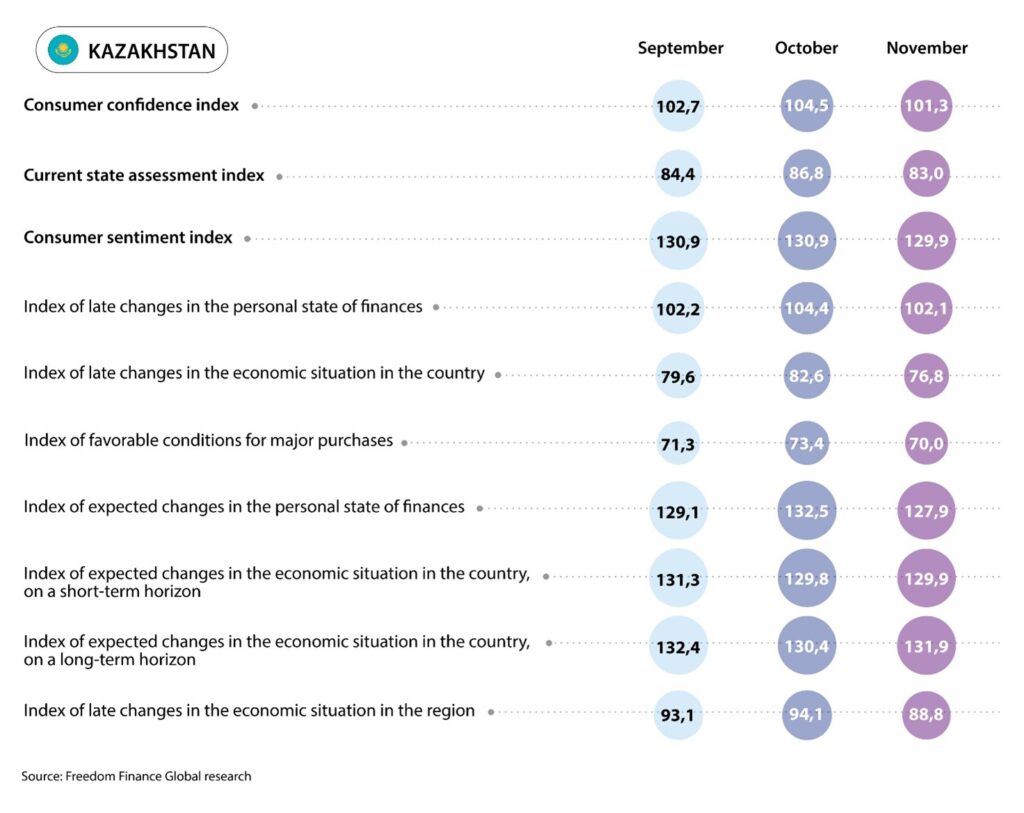
Inflation expectations for the month ahead have risen sharply
Inflation estimates of Kazakhstan residents in November showed a noticeable increase after the record lows in October. Over the past month, 40.9% of respondents (37.5% in October) indicated a strong increase in prices. Over the course of the year, the increase in the share of those who noticed a rapid increase in prices was slightly less significant: from 47.5% in October to 49.9% at the time of the last data collection. However, we note that both indicators are close to the average level for the previous six months.
But inflation expectations of Kazakhstanis showed a much greater increase compared to October, once again updating the maximums of this year. The share of people expecting a strong increase in prices in the horizon of one month increased sharply from 21.9 to 30.6%, while in the horizon of the next 12 months, the share of those expecting an acceleration in price growth increased from 25.4% in October to 27.5% – at the time of the last survey.
A similar study by the National Bank of the Republic of Kazakhstan on inflation estimates and expectations demonstrated similar dynamics after the October multi-month lows. According to the data presented, the share of those expecting a strong price increase during the year increased from 19.9 to 22%. While in the horizon of one month, the same indicator increased sharply from 18.1 to 27.1%. Inflation estimates also showed a slight increase, as in our study. If the share of respondents who assessed price growth over the past month increased from 27.9 to 32.4%, then the share of those indicating a rapid price increase over the previous 12 months increased from 39.4 to 40.2%.
Among individual goods and services, the majority of respondents are still concerned about the significant increase in food prices. The top 4 goods that have become most noticeably more expensive for the population have remained unchanged for many months in a row. They include the categories “Meat and poultry”, “Milk and dairy products”, “Bread and bakery products” and “Vegetables and fruits”. Despite the growth of inflation estimates in November, on average, the share of people who noticed a strong increase in prices for all of the above products fell by 4.1 percentage points compared to October. The share of those who noted a significant increase in the price of bread and bakery products decreased most noticeably – from 26.8 to 21.1%. It is also necessary to note the record low indicators for such products as “Flour” and “Sugar with salt”. Only 12.8% of respondents chose the first product and 11.5% – the second, which is approximately 7-8 percentage points less than in October. According to official statistics, prices for meat and poultry increased in November by only 0.2% m/m, while prices for bakery products and cereals fell by 0.1% m/m. At the same time, fruits and vegetables showed a seasonal increase in price by 6.3% compared to October – largely due to cucumbers and tomatoes.
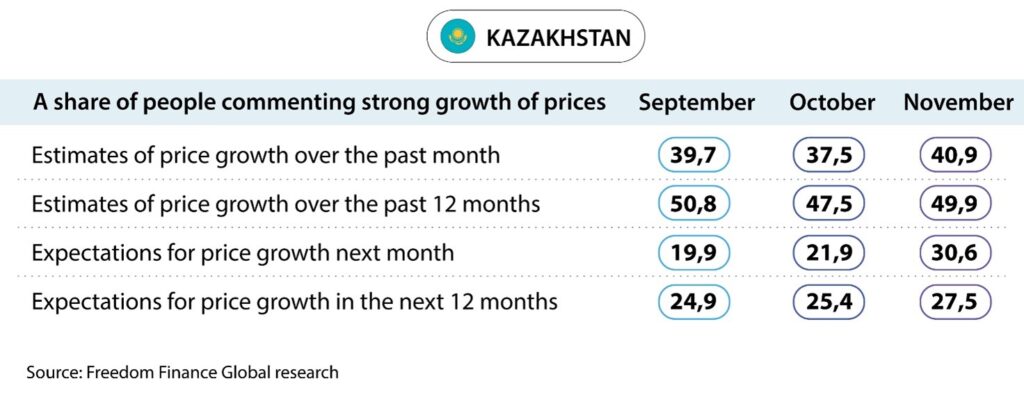
Devaluation expectations continue to break records
Devaluation expectations of Kazakhstanis continued to grow in November and reached new record values for the entire period of the study against the backdrop of an increase in the dollar exchange rate by more than 5% in a month. According to the survey results, the share of Kazakhstanis expecting the tenge to weaken over a one-year horizon increased from 59.3 to 60.7%. And over a one-month horizon, there was a much more noticeable increase – from 40.5 to 44.9%. It should be noted that, compared to November 2023, the share of pessimists increased by 5.2 percentage points for the first question and by 8.7 percentage points for the second.
Uzbekistan
The consumer confidence index of Uzbeks in November 2024 showed a decline after strong growth in October, falling from 132.5 to 129.5 points. Separately, there was an improvement in four of the five sub-indices that determine the index. The sub-index of the favorability of current conditions for large purchases showed the largest decline. Compared to November 2023, the CCI also fell by 2.7 points, largely due to a drop in optimism regarding the economic situation.
Conditions for large purchases have become worse
In November, the sub-index of current favorable conditions for major purchases fell from 90.7 to 84.2 points. This was the third worst result for the entire period of the study. Almost 39.3% of Uzbek respondents believe that conditions for major expenses are favorable, which is 2.6 percentage points less than the October figure.
Negative dynamics are not observed in all age groups. The exception in November were respondents aged 45–59, among whom the share of optimists increased from 41.5 to 42%. This indicator turned out to be the best among all groups of respondents. The greatest decline was recorded among young people, 39.4% of whom note the favorable current conditions for large purchases, while in October such respondents accounted for 45.8%. However, the worst respondents were those aged 30–44, with a similar share of 37.9%.
In regional terms, compared to October, the most noticeable deterioration is recorded in the Navoi Region, where the share of positive responses fell by 13.5 percentage points, amounting to 33.1%, which was the lowest result among all regions. The share of optimists in the Karakalpakstan Region and the Kashkadarya Region also fell by almost 8 percentage points. At the same time, the opposite dynamics can be noted in the Syrdarya region, where the share of people indicating the favorability of current conditions for large purchases increased from 36.9 to 49.1%. Nevertheless, the Khorezm Region remains the leader with a share of positive responses of 50.7%, which is 2.6 percentage points higher than in October.
Decreased optimism about the personal financial situation
Another sub-index that fell significantly in November was the change in personal financial position over the past year. The previous level fell by 3.1 points, but the indicator still remains the second best in the past eight months. Just under 60% of Uzbek residents chose the positive answer, while in October there were 62.2%.
Negative dynamics are again demonstrated by all age groups, except for the oldest generation over 60 years old. If in the previous month, the share of positive answers of the latter reached 49.1%, then in November it grew to 53.1%, but at the same time, it is still the lowest result among all surveyed categories. The best result is still demonstrated by young people under 29 years old, among whom 69.2% were optimists, which is 3.8 percentage points less than in October. The dynamics of the other two age groups were similar. Among people aged 30–44, the share decreased by 3.2 p.p., and among residents aged 45–59 – 3.4 p.p.
In regional terms, the most active decrease in the indicator occurred in the Fergana Region. There, the share of respondents who chose positive answers fell from 68.3 to 57.5%. However, this was not the worst result in November, as it was recorded in the Tashkent Region – 55%. Also, the shares of optimists in the Jizzakh Region and the Bukhara Region fell by a noticeable 8.3 p.p. and 8.2 p.p., respectively. Positive dynamics in November were noted in six regions at once, but the strongest – in the Andijan Region (from 57.6 to 66.1%). At the same time, the highest indicator of improvement in personal financial position was among residents of the Syrdarya Region, where the share of positive answers reached 67.2%.
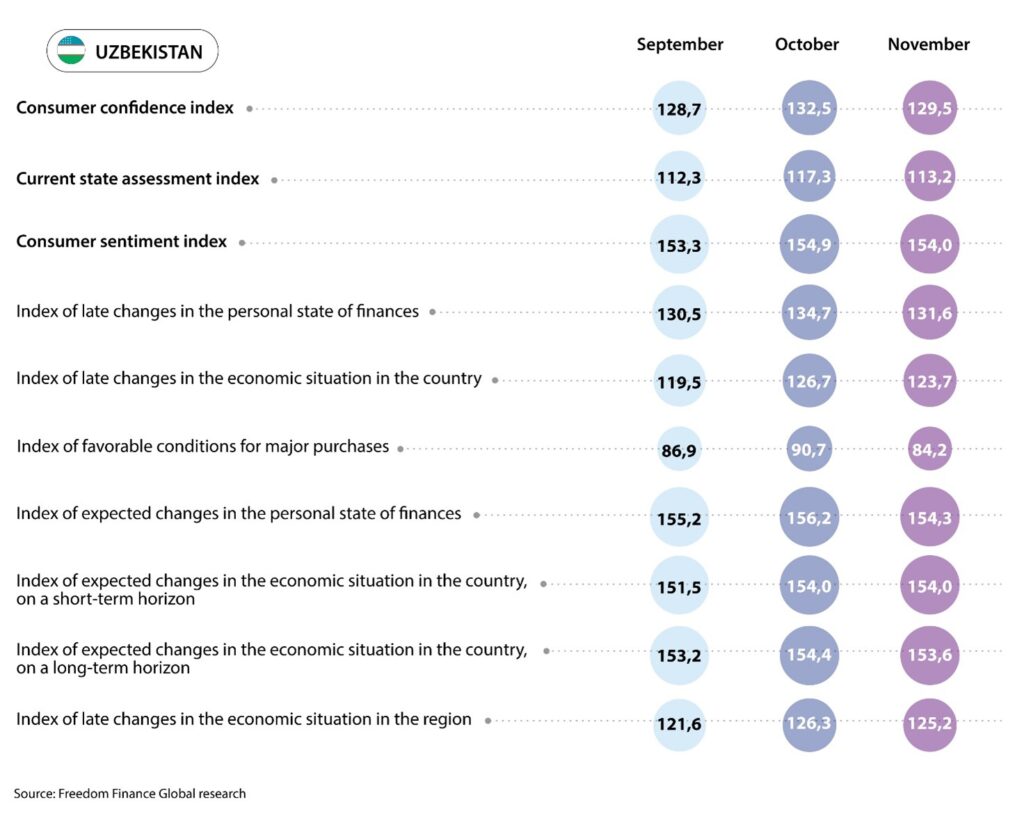
Inflation expectations and estimates have worsened significantly
Inflation estimates and expectations of residents of Uzbekistan in November showed a general increase after the October decline. Thus, over the past year, 50.7% of residents felt a very strong increase in prices in November against 48.6% in October. But in the horizon of the past month, the share increased slightly, from 29.9 to 30.8%.
Inflation expectations showed an even more noticeable deterioration compared to October. The share of those expecting a strong price increase next month increased from 18.8 to 26.5%. This was the highest result for the entire period of the study. And in the one-year horizon, 26.2% of respondents expect faster price growth, which is 2 p.p. higher than the October indicator.
However, according to official statistics, in November, a monthly price increase of 0.93% was recorded, which is a record low for this period since at least 2011. Against this background, annual inflation has noticeably decreased from 10.24 to 10%. Note the continued slowdown in the monthly growth of meat prices, primarily beef. Nevertheless, this continues to have a noticeable impact on the mood of respondents. Almost 58% of them indicated the Meat and Poultry category, as a product for which a strong price increase is noticeable, while in October there were 60.2%. In general, these shares for many products have changed insignificantly compared to October. Slightly more people note fruits and vegetables (+3.3 p.p.) and vegetable oil (+2 p.p.). On the other hand, fewer respondents noticed a strong increase in prices for housing and communal services (-1.4 p.p.) and flour (-0.7 p.p.), the share of which is at absolute minimums for the entire period of the study. It should be noted that, according to official statistics, oils and fats increased in price by 2.7% MoM in November, while a decrease in the price of flour by 3.1% over the past year is recorded, which corresponds to the mood of the surveyed residents. In addition, a noticeable monthly increase in the price of vegetables by 9% most likely negatively affected the moods of the respondents.
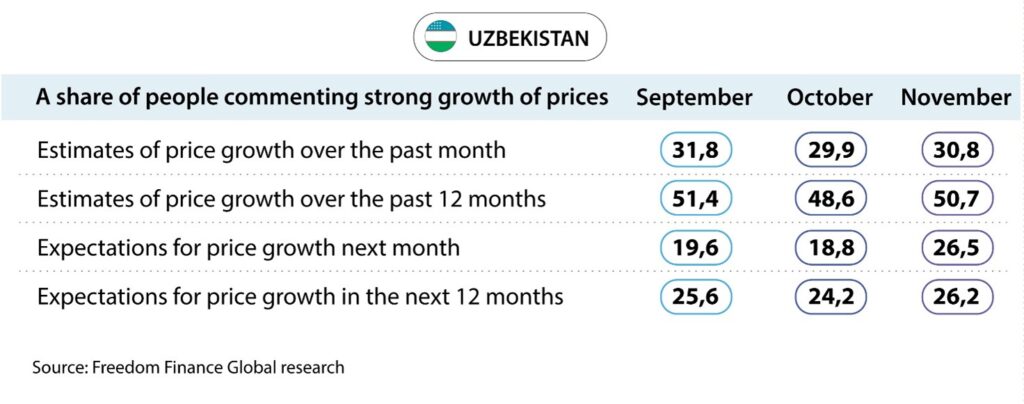
Devaluation expectations halt growth
In November, devaluation expectations of residents of Uzbekistan remained virtually unchanged compared to October after two consecutive months of growth. The Uzbek som weakened in November, which has been happening for the fourth month in a row, this time the growth rate of the dollar reached 0.6%. The share of those who expect the national currency to weaken against the dollar over the next 12 months remained at the same level of 60.5%. But in the horizon of one month, the share of pessimists increased slightly from 42.7 to 43.5%. These figures have become the highest in the past six months, but they are still noticeably lower than the levels of November 2023.
Kyrgyzstan
In Kyrgyzstan, the consumer confidence index showed a partial recovery in November after two consecutive months of decline. The CCI increased by 1.4 points over the month, reaching 138.6 points. Four of the five subindices that determine the composite level of the index demonstrated growth. The largest increase was recorded in assessments of changes in the economic situation over the past 12 months. Compared to November 2023, the index growth was more impressive 6.8 points.
Economic situation assessments have partially recovered
The sub-index of assessments of changes in the economic situation over the past 12 months showed a good recovery of 3.9 points in November, after a sharp decline. The indicator reached 150.8 points, which was the third-best result in the entire study. Almost 70% of residents indicated improvement in the economic situation, while in October this indicator reached 67.7%.
In terms of age, growth is observed across the entire spectrum, except for the older generation over 60 years old. Slightly more than 72% of the country’s residents in this category noted improvement in the economic situation, while in October there were 72.7%. Nevertheless, the leadership with a slight advantage was taken over by respondents aged 45–59, among whom the share of positive answers sharply increased from 64.3 to 72.3%. Also, the number of optimists among the 30–44 age group increased by 1.5 percentage points, while among young people under 29, changes are noticeable only in the share of people who chose an unambiguously positive answer.
In terms of the regions, negative dynamics in improving assessments of changes in the economic situation are observed only in a couple of regions. The Talas Region remains the leader, where the share of positive responses has slightly increased, from 80.5 to 81.7%. The best monthly dynamics were shown by the capital, where this indicator increased from 50.7 to 57.3%. However, this result was still the lowest among all regions. The share of optimists in the Chu Region also increased by 6.1 p.p. On the other hand, noticeable negative dynamics are recorded in the Issyk-Kul Region (–7.1 p.p.) and Osh (–5.3 p.p.).
Significant year-on-year increase in favorable conditions for major purchases
In November, the sub-index for favorableness of current conditions for major purchases recovered slightly by 1.1 points, reaching 105 points after three consecutive months of decline, which remains the highest among the four countries in the region. However, compared to November last year, the increase was a significant 10.3 points. Thus, the share of people indicating favorable conditions for major spending increased from 39.1% in November 2023 to 43.5% a year later.
At the same time, only two age groups showed an annual increase in optimism. The best dynamics and results were noted among young people under 29. There, the share of people who consider the current conditions for large purchases to be at least more favorable increased from 39.6% in November 2023 to 51.1% today. The same share among people aged 30–44 also increased by 4.2 p.p.. On the other hand, in the age group 45–59, there was a slight decrease in the share of optimists to 37.1%, which was the worst result in November.
It should also be noted that the annual increase in the share of positive answers is not observed in all regions of the country. The worst answers were given by residents of the Chui Region, where only 29.3% consider the current conditions for large purchases favorable, and this is 5.8 p.p. less than a year ago. The strongest growth is observed in the Talas Region, where the increase in the share of positive answers was 21.9 p.p. The region has also become the leader in the country in this issue. The share of optimists in the Osh Region has also noticeably increased over the year, from 39.3 to 54.6%.
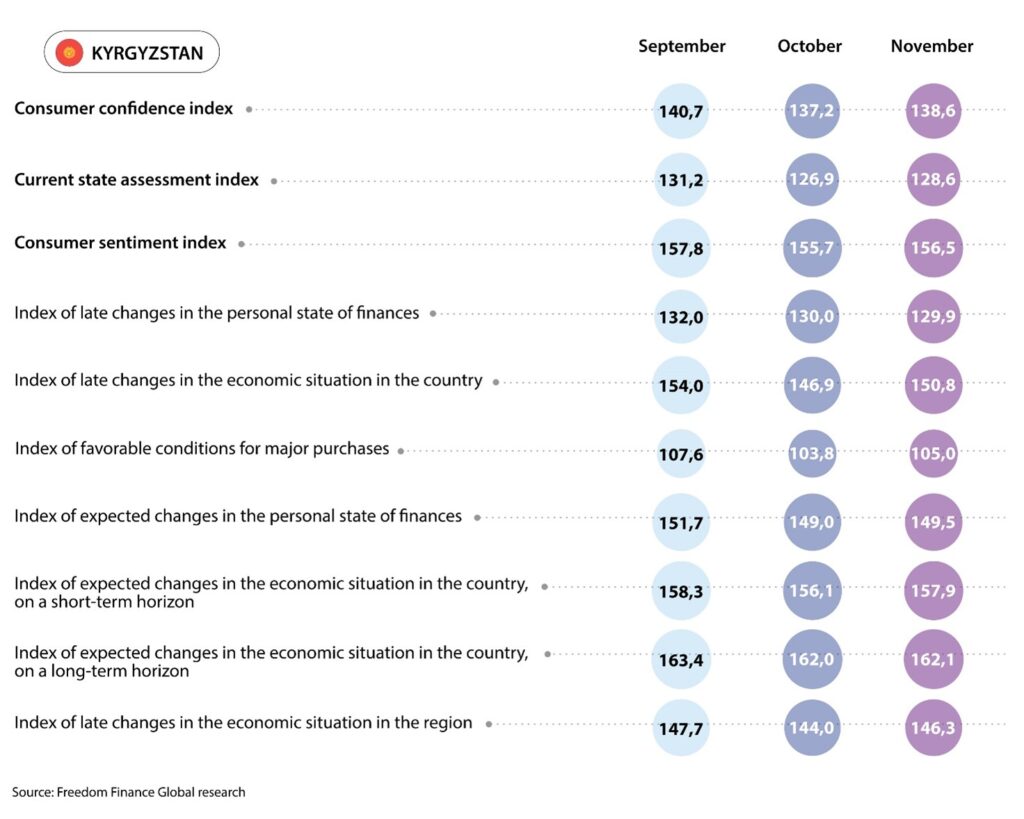
Inflation estimates and expectations showed deterioration
Inflation estimates of Kyrgyzstanis showed a noticeable increase in November, having lost almost all of the improvement of October. If last month 26.6% of respondents felt a very strong increase in prices over the past month, then in November there were already 32.7% of such people, which is a 13-month maximum. Estimates of price growth over the past 12 months also increased, but only slightly. In November, 49.6% of the Kyrgyzstanis noted an acceleration in their growth, while in October this indicator was 47.8%.
Inflation expectations of the Kyrgyzstanis have not grown as significantly as inflation estimates and generally remained close to previous low levels. The share of respondents expecting a faster increase in prices in the next 12 months increased from 13.7 to 13.8%. The share of those who believe that prices will rise significantly next month increased from 7.7 to 10.2%, which is still the maximum since September 2023.
Among the separate goods and services for which residents noticed the greatest price increase, we again note the Meat and Poultry category, which has held the first line for the third month in a row. The share of respondents who chose it has remained virtually unchanged over the month, amounting to 47.9%. At the same time, the most noticeable increase in the share among the main goods and services is observed for vegetables and fruits. If in October 32.6% of respondents noticed a strong increase in prices for them, then in November their share increased to 41.5%, which is the highest value since August 2023. It should also be noted that, in general, the list of five goods for which the greatest price increase is noticeable has not changed for 15 months in a row. In addition to the above-mentioned products, in November 46% of respondents noticed a strong increase in prices for vegetable oil, 44.9% for flour, and 33.4% for sugar and salt.
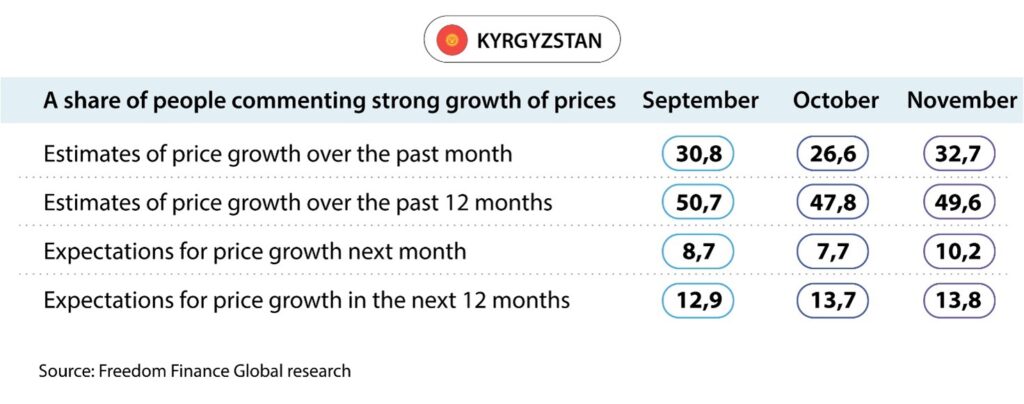
Devaluation expectations rise for the second month in a row
The Kyrgyz som weakened by more than 1% in November, and this is happening for the second month in a row. As a result, devaluation expectations of the Kyrgyzstanis have grown significantly. If in the previous month, 25.4% of residents expected the national currency to weaken in a year, then in November the share of such people increased to 30.1%. And in the issue of dollar growth in the horizon of one month, the share of pessimists increased from 17 to 21.8%.
Tajikistan
The consumer confidence index in Tajikistan showed a good recovery in November after three consecutive months of decline, from 148.8 to 150.9 points. Four out of five sub-indices showed monthly growth, but we especially note the significant improvement in personal financial position assessments to record levels. Compared to November last year, the CCI fell by 0.2 points, mainly due to worsening assessments of favorable conditions for large purchases.
Personal financial situation assessments have improved significantly
Residents’ assessments of changes in their personal financial position in Tajikistan showed the most noticeable improvement compared to October. This sub-index increased from 145.7 to 153.7 points, which became a record for the entire period of the study. The share of the optimistic Tajiks in November was 73.2% against 67.3% in October.
In terms of age, an increase in the proportion of optimists was recorded in all age groups. This is most pronounced among residents of the country aged 45–59, where the proportion of those who positively assessed changes in their personal financial position increased from 60 to 73.1%. Young people under 29 also showed good growth, from 70.7 to 77.7%, which was the best result in November. Respondents aged 30–44 responded the worst, where the proportion of positive answers reached only 68.9%.
All regions have recorded a monthly increase in the proportion of residents who noted improvement in their personal financial position over the past 12 months. The greatest increase is observed in Dushanbe, where this share has increased from 52.7 to 69.2%. However, the best indicator (75.7%), with a very small gap from the Khatlon Region, was shown by the Gorno-Badakhshan Autonomous Region. The worst response was given by residents of the Regions of Republican Subordination, where, however, the share of positive responses increased from 64.1 to 69.1%, which is only 0.1 p.p. less than the capital’s indicator.
Conditions for large purchases have improved slightly
The sub-index on favorableness of current conditions for major purchases and expenditures increased by 2.3 points in November, compared to October, reaching 84 points. This indicator is, however, significantly lower than in June–September. Almost 41% of respondents gave positive answers, while in October this figure was 40.2%. At the same time, the share of clearly positive answers increased by 2 p.p.
Mixed dynamics were observed across age groups. The most noticeable growth was among people over 60. If in October the share of optimists in the older generation group reached 39.1%, then in November it rose to 43.1%. However, the best result was shown by young people under 29, among whom this indicator fell slightly, from 44.9 to 44.2%. The share of positive answers among respondents aged 30-44 also increased by 3.8 p.p.. The worst answers were given by respondents aged 45-59, where only 35.9% noted favorable conditions for large purchases.
In terms of the regions, improvement is also not observed everywhere. It is most noticeable in the Regions of Republican Subordination, where the share of positive responses increased from 35.8 to 40.2%. Nevertheless, the best indicator in November was demonstrated by the Gorno-Badakhshan Autonomous Region – 51.8%. But the greatest decline occurred in Dushanbe, where 37.7% of respondents believe that the current conditions are favorable for large purchases (40.4% – in October). This indicator turned out to be the worst among all regions of the country.
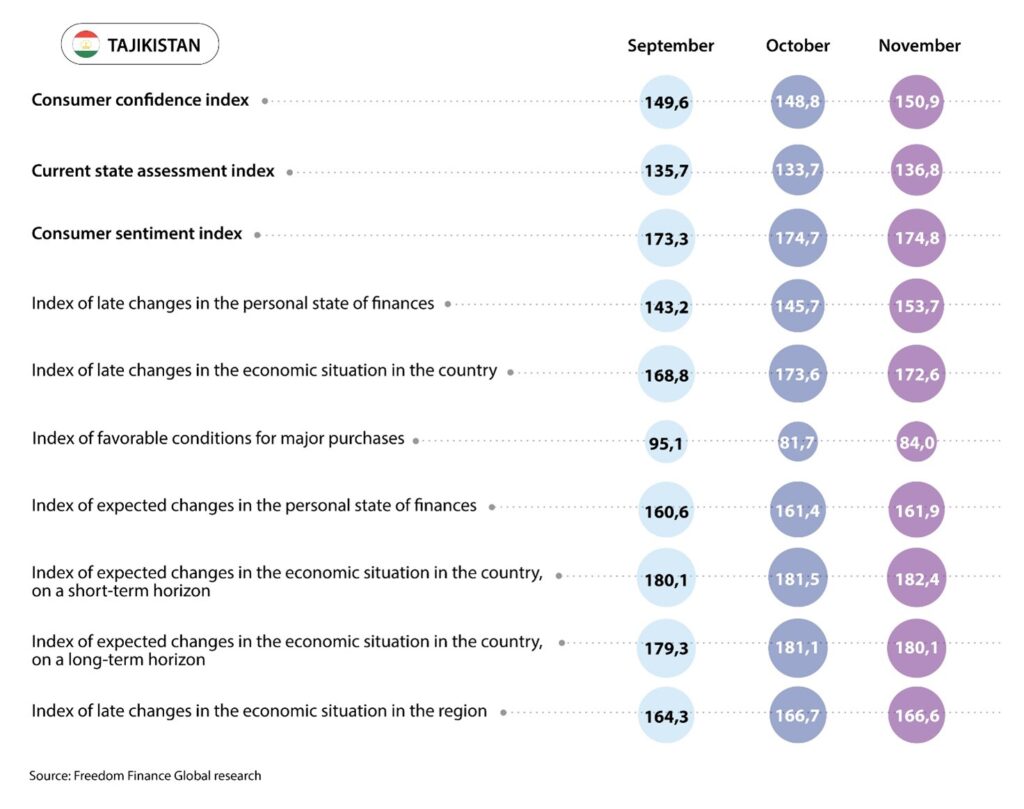
Inflation sentiment has worsened
In November, Tajik inflation estimates showed a slight increase after the October improvement. The share of respondents who noted a price jump over the past month increased from 23.9 to 26.4%. In the past 12 months, the share of those who felt a faster price increase increased from 26.6 to 28%. Inflation expectations of the Tajik residents showed a less significant monthly deterioration. Slightly less than 12% of residents expect a very strong price increase in the coming month, while in October there were 10.4%. And in the horizon of the next 12 months, the share of pessimists increased from 12.8 to 13.7%.
Official inflation data for November has not yet been published, but annual inflation accelerated again in October from 3.1 to 3.6%. Among commodity items, the Tajik residents continue to be greatly concerned about the prices of meat and poultry. However, over the past month, the share of people who have noticed a significant increase in prices for this category has fallen after five months of growth, from a record-high 58.1 to 50.6%. The level of concern for other food products has also noticeably decreased. For flour, this figure fell from 34.2 to 26.4%, for vegetable oil, from 35.5 to 26%, and for fruits and vegetables, from 21.9 to 15%. It should be noted that these four food products have remained among the leaders throughout our study. According to official statistics, in October, prices for meat and meat products continued to accelerate, increasing by 3.2% MoM, and for beef separately, by 5.4% MoM. Thus, over the year, prices for meat, as a whole have already increased by 15.7%, and for beef, by 26.5%, which respondents clearly could not help but notice in October. Other food products do not show such price growth. We will only note their decline for fruits (-2.7% MoM), vegetables (-1.7% MoM) and a slight increase in the price of vegetable and animal oil by 0.7% MoM.
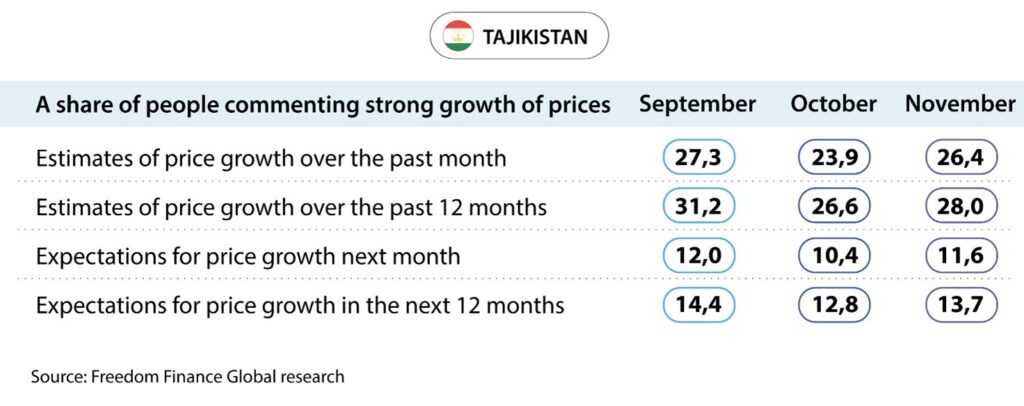
Devaluation expectations have risen again
Devaluation expectations in Tajikistan showed some growth in November, especially over the next 12 months. It is worth reminding that the dollar exchange rate against the somoni rose by more than 2% in November, which was the largest monthly growth since February 2023. The share of those expecting the national currency to weaken within a month increased from 18.7 to 19.5%. But over the horizon of one year, 28.8% of the country’s population expects weakening (23.1% in October), which is the maximum since August 2023.
Conclusions
November 2024 turned out to be mostly negative for the Central Asian countries, especially in terms of inflation and expectations of weakening national currencies. In Kazakhstan, a decrease in the consumer confidence index was recorded after two consecutive months of growth. At the same time, the index lost all previous growth and turned out to be the lowest since May 2024. It is necessary to note a significant deterioration in residents’ assessments of changes in the economy, as well as a more moderate decrease in optimism in assessing and forecasting changes in personal financial situation. Negative dynamics of the index were also recorded in Uzbekistan. Nevertheless, October’s progress was not completely lost; this year, a lower value of the index was recorded for four months. Significant deterioration occurred in favorability of current conditions for large purchases. At the same time, fewer residents believe that their financial position has improved over the past year, as well as the economic situation in the country. Compared with last year’s November, the CCI in Uzbekistan decreased by 2.7 points, indicating a general negative trend in 2024.
On the other hand, in Kyrgyzstan, the CCI recovered in November, after two consecutive months of decline. However, the index failed to even come close to the September level. A noticeable recovery occurred, in terms of the changes in the economic situation, which significantly pulled the overall index down in October. In terms of other issues, the increase in optimism is much less noticeable, although economic forecasts have almost returned to record levels. Compared with November 2023, the index still shows a significant increase of 6.8 points. The CCI regional leader, Tajikistan, also recovered after a continuous three-month decline in a row. The growth rate turned out to be much higher than that of its eastern neighbors, almost completely recouping the losses of the previous two months. This happened due to sharp improvement in assessments of changes in personal financial position to record levels. Residents’ assessments of the favorability of current conditions for large purchases, which became the main factor in the decline in October, also slightly recovered. Compared with last year, the CCI in Tajikistan remained virtually unchanged, falling by 0.2 points.
The dynamics of inflation estimates and expectations in November turned out to be negative across the region after a good October. It should be noted that the general deterioration in inflation moods has occurred in three of the last four months.
In Kazakhstan, inflation expectations have increased sharply, reaching their maximums since December 2022 in the one-month horizon. Inflation estimates have also worsened in this horizon, losing all progress from May to October. In Kyrgyzstan, inflation estimates have also significantly worsened in the past month, reaching their highest value in 2024. On the other hand, inflation expectations, although slightly increased, are still quite low. In Uzbekistan, this indicator, as in Kazakhstan, has increased significantly. In the one-month horizon, a record number of people for the entire period of the study expects a noticeable increase in prices. Otherwise, there is also a slight deterioration in this issue. In Tajikistan, the dynamics of inflationary sentiment are similarly negative, but its rates are insignificant, unlike all other countries in the region. And in general, the indicators have remained virtually unchanged over the year, except in relation to estimates of price growth over the past 12 months.
Devaluation expectations in Central Asian countries have generally shown growth again. Almost all countries are seeing a weakening of their national currencies. We note the continued growth of devaluation expectations in Kazakhstan against the backdrop of new historical records of the USD to KZT exchange rate. The indicators have updated their absolute maximums for the entire period of our study. In Kyrgyzstan, for the second month in a row, there has been a noticeable increase in devaluation expectations against the backdrop of the weakening of the som in October-November. The share of those expecting the som to weaken has reached multi-month records.
In Tajikistan, where there are usually no sharp changes in this regard, the share of those expecting the dollar to grow within a year has grown to a virtually record high. Only in Uzbekistan was the growth of devaluation expectations insignificant, however, they continue to be the highest in all of Central Asia. The share of those expecting the sum to weaken within a month has grown by only 0.8 p.p.
The seventeenth wave of the consumer confidence survey in four Central Asian countries showed mostly negative results across countries and key issues. Two countries are recording a recovery in consumer confidence, while the other two are showing the opposite. Moreover, compared to October, these two pairs have simply swapped places. Given the constant changes in the CCI in different directions, we can say that consumer confidence has been holding at about the same level throughout the region for the past four to five months. The previous two-month growth in Kazakhstan, the decline in the same months in Kyrgyzstan, and a similar three-month process in Tajikistan finally reversed in November. And the good growth in Uzbekistan in the previous month went down, showing swings from month to month since August. Another important event in this wave of the survey was the almost universal deterioration in inflation estimates and expectations of the population. This is especially noticeable in certain issues, where respondents noted a sharp increase in pessimism. We are noting the third such period in the past four months. Devaluation expectations again showed a universal increase. As a result, November can definitely be called negative for Central Asia, in terms of structural changes in the mood of the population.













